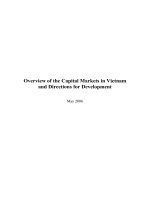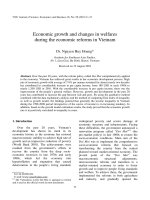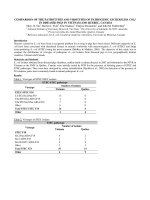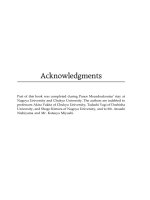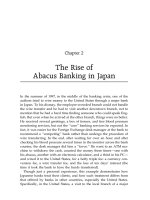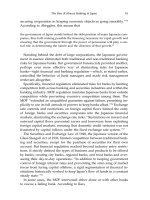Comparing Judicial Reforms in Vietnam and China
Bạn đang xem bản rút gọn của tài liệu. Xem và tải ngay bản đầy đủ của tài liệu tại đây (426.88 KB, 15 trang )
Comparing Judicial Reforms in Vietnam
and China
Bui Thi Thu Hien1
1
Institute of Chinese Studies, Vietnam Academy of Social Sciences.
Email:
Received on 13 August 2018.
Revised on 16 August 2018.
Accepted on 13 November 2018.
Abstract: Vietnam and China are two neighbouring countries with many similarities in
economic, political and cultural affairs. In the context that the open door renovation/reform in
both countries are underway, the two countries encounter many common issues which are
suggestive to each side. Judicial reforms in the two countries have similarities and dissimilarities
due to their population sizes and development. Based on the judicial reform context in each
country, this paper compares the similarities and dissimilarities of the current judicial reforms in
Vietnam and China.
Keywords: Reform, institution, justice, China, Vietnam.
Subject classification: International studies
1. Introduction
Vietnam and China are among the few
socialist countries which have implemented
renovative reforms and transformations
from planned economies to market-based
economies quite successfully. In those
transformation processes, institutional
reforms are a crucial factor in ensuring the
reform s
success.
Together
with
institutional reforms in legislation and
execution, judicial institutional reforms are
also among the important tasks of the two
countries. Due to numerous similarities in
the political institutions, the judicial
institutional reforms of each country also
have many things in common. However, the
judicial institutional reforms in the two
countries have some dissimilarities because
of the different population size and
development in each state. Researching and
comparing these judicial institutional
reforms in Vietnam and China will offer us
useful lessons and experience for the reform
process of each country.
2. Contexts of judicial institutional reforms
in Vietnam and China
Judicial reforms are components in the state
apparatus having a close relationship with
3
Vietnam Social Sciences, No. 1 (189) - 2019
administrative reforms and are integral
parts in the development of a rule-of-law
(defined by Vietnam) or rule-by-law
(defined by China) socialist state. In
addition, a judicial reform needs to be
implemented profoundly and comprehensively
to meet the requirement that the state
power is unified with the allotment,
collaboration and control among state
agencies in their implementation of
legislative, executive and judicial powers
[9]. Therefore, judicial reforms cannot
stray from the development of a state of
the people, by the people and for the
people [11]. Judicial reforms are also
tasked
with
realising
regulations,
institutions and mechanisms of power
control [10] in the reform at present and in
the following years. In the context that
Vietnam sets the target of a wealthy
people, strong, democratic, equitable and
civilised country [5] and China outlines
the target of comprehensively building a
moderately prosperous society [35], based
on a market economy and the equitable
justice [20], the judicial reforms in both
countries, in conclusion, need to be very
cautious and selective to every single issue
to match the socio-economic development
in each country’s development phase [36].
In Vietnam, after nearly 10 years of
implementing the renovation process,
Resolution No.49-NQ/TW dated 2 June
2005 by the Politburo on the judicial reform
strategy to 2020 clearly determined the
motto Judicial reform must originate from
the requirement of
socio-economic
development and strong national defence in
close linkage to the legislative work and
administrative reform . The Communist
Party of Vietnam set clear requirements for
4
the connection between the three power
branches and synchronous reforms in all
those three branches. Legislative reform will
not be effective without the accompaniment
of executive and judicial reforms. Flying
higher on the previous Congresses views on
judicial reform, the 12th National Congress
of the Party (or the 12th Congress) clearly
pointed out that the judicial reform in
Vietnam remained slow with instances of
harassment, negative phenomena, injustice,
misjudgement and untrialed crime [2]. The
Congress also found the reasons for such
downsides, specifically Building the ruleof-law socialist state is a new issue of our
country. The dichotomy between the Party s
leadership role and the state s management
role still has some ambiguous points and is
not in line with the rule-of-law state
principle. The working of compliance with
law and socialist legislation remains
insufficiently serious [2]. Hence, it is
necessary to continuously promote and
implement the judicial reform strategy;
develop a pure, strong, democratic, strict and
gradually-modern justice sector; protect the
law, justice, human rights, citizen rights,
socialist regime, state s interest and
legitimate rights of agencies, organisations
and individuals and delineate administrative
management authorities and judicial
liabilities as well as rights in the organisation
and operation of judicial organs [2].
The judicial reform in China is tabled for
discussions from the 15th Congress (1997),
which concluded that it was necessary to
promote the judicial reform and ensure the
independent jurisdiction and prosecution of
judicial bodies [37]. Since 1999, the
Supreme People s Court has issued the
fundamentals of the five-year reform three
times. However, not until 2004 did China
Bui Thi Thu Hien
launch its judicial reform in a large scale
with the unity in planning and
implementation, starting from decisive
points, which are prominent issues with
strong reactions from Chinese people and
impacts on the equitable justice sector,
finalising the structuring and planning of the
management function and mechanism of
judicial bodies based on the sector s features
and strengthening the judicial mechanism
with clear responsibilities, collaboration,
mutual control and effective operation [20].
As of 2008, China continued to start a
new judicial reform phase with the priority
to deep, focused and systematic judicial
reforms. The reform needs to originate from
the requirements for the justice sector of the
people; prioritise the people s common
interests; target primarily the promotion of
a harmonised society; focus on strengthening
the power control and supervision; grasp
thoroughly key factors which can affect the
equitable justice sector and impede the
judicial capacity and address institutional,
mechanical and assured obstacles. It is also
crucial to enhance the judicial contingent
and ensure the judicial expenditure [21].
On 20 October 2014, the 4th plenary
session of the 18th National Congress of the
Communist Party of China was summoned
with the topic comprehensively promoting
the development of a rule-by-law state .
Based on the 3rd plenary session of the 18th
National Congress, China continued to
carry out intensive reforms to ensure an
equitable justice sector with such specific
tasks as the Supreme People s Court
established circuit courts (巡回法院),
setting up people s courts and people s
procuracies across different administrative
divisions (跨行政区划的人民法院和人民检察
院), exploring and formulating the public
litigation mechanism of procuracies (公益
诉讼制度), promoting the reform towards an
jurisdiction-centred litigation mechanism,
etc. Hence, it can be understood that the
judicial reform in China after the 18th
Congress continued to be deepened with a
wide range of specific measures and models
applied for the first time.
Researching further the judicial reform
in China, one can conclude that the three
main factors impacting the equitable justice
in China are The interference from
external factors, the internal intervention of
judicial bodies and individual binds of
judicial officials [38]. Accordingly, external
factors are associated with the localism in
the justice system, while the internal
intervention of judicial bodies has a relation
to the internal red tape in judicial bodies.
The personal binds of judicial officials are
closely linked to the finalisation of external
monitoring mechanisms such as the Party s
monitoring of judicial bodies or the
supervision committee s monitoring of
judicial bodies [38]. Therefore, the most
important target of the judicial reform in
China is to eliminate the localism and
bureaucracy in judicial bodies and
continuously enhance the independent
monitoring system. In short, the judicial
reforms in Vietnam and China both started
after the two countries have conducted their
open reforms for ten years. Obviously, after
transforming from centrally planned
economies to market ones, both countries
face many institutional issues. Hence, in
addition to legislative and executive
institutional reforms, the judicial reform is
implemented to create synchronicity in the
political system reform.
5
Vietnam Social Sciences, No. 1 (189) - 2019
3. Comparing judicial reforms in Vietnam
and China at present
The more we learn about the judicial reforms
in Vietnam and China, the more similarities
we can find in their targets, contents and
methods. However, due to the differences in
population size and development level, some
aspects of the judicial reforms in Vietnam
and China are different.
3.1. Reform targets
Vietnam and China have similar political
systems, in which the Communist Party leads
both countries and forms the socialist rule-oflaw model (for Vietnam) and the socialist
rule-by-law model (for China). Regarding the
state apparatus, the two countries do not
recognise the Western state model of
separation with three independent bodies,
legislative, executive and judicial agencies,
which check and balance one another.
Therefore, in reforming political institutions
to meet the requirement of building a market
economy, both countries must work out the
most appropriate model to promote economic
development, continuously expand the
people’s rights as masters in all spheres,
avoid drifting away from the socialist
orientations and persist with the Party’s
unified leadership. In the institutional political
reform in general and judicial reform in
particular, the two countries have set the
following target of building a clean, strong
and democratic justice system. In order to
fulfil this target, it is necessary to strengthen
the external monitoring body continuously.
Overarching targets of the judicial reforms in
Vietnam and China are thus the same and
both aim to build a democratic justice sector,
6
which protects justice and continuously
improves the justice system to better protect
human rights for the people. Specific targets
of the reform are listed as follows:
- In Vietnam: during judicial reform
periods in Vietnam, it can be seen that the
main target of the judicial reform in
Vietnam is to build a clean, strong,
democratic justice sector which protects
justice” [17]. In addition, it aims to
gradually build a modern justice sector,
which moves towards better serving the
people and the socialist development.
- In China, six main targets are identified
as followings: building and consolidating
the independent jurisdiction and procuracy
system; optimising the functions of judicial
bodies by strengthening police departments,
procuracies, courts and judicial administrative
agencies; promoting a strict justice sector
based on the development of a judicial
assessment mechanism and a system of
criteria for case adjudication; persistently
building a justice sector for the people and
by the people to promote judicial
equitability based on the consolidated
people s jury system and public judicial
mechanism; continuously ensuring judicial
human rights to secure the right to know,
report and defend in the course of litigation
and strengthening the judicial activity
supervision on the basis of finalising the
legal system of monitoring bodies [39].
3.2. Reform contents
For Vietnam, Resolution No.49-NQ/TW on
the judicial reform strategy to 2020 has
emphasised the reform mandates of judicial
agency system such as courts, procuracies,
investigation agencies or judicial support
Bui Thi Thu Hien
organs [13]. Similarly, the judicial reform
in China has also witnessed these issues
with relatively specific contents to create
synchronicity in the reform process [40].
This is also the tendency of judicial reforms
in other countries around the world with a
view to establishing a system of independent
and effective judicial bodies [18]. However,
when reviewing the judicial reforms’
contents of Vietnam and China, the judicial
reform in Vietnam has been conducted in
quite a synchronous manner with legislative
and executive reforms. In terms of
legislation, Vietnam has made a wide range
of amendments to its constitution (revising
constitutional principles on the functions of
a court and procuracy), followed by the
amendment of specialised laws. Meanwhile,
for China, the functions of judicial bodies
such as courts and procuracies are specified
in the People s Court Organisation Law
[22] and the People s Procuracy Organisation
Law [23]. China has recently revised the
Chief Prosecutor Law and the Chief Judge
Law in 2017 and 2018 towards increasing
the liability and independence in the
jurisdiction of these positions in the judicial
agency system. In addition, there have been
important adjustments in the system of
agencies involved in judicial activities such
as investigation agencies and judicial
support organs (lawyers and notaries) [24].
In the court system, China has initially built
a number of specialised court models such
as circuit courts or administrative courts
across different administrative divisions2.
These efforts are aimed at reducing the
administrative burden on the judicial
agency system such as courts. The contents
of reforms in Vietnam and China are
specified as follows:
- In Vietnam:
For the court, “fully specifying the
constitutional principles on functions and
tasks of the People s Court and adjudication
activities, organising the courts based on their
jurisdictions, ensuring the principle of
independence and adversarial litigation in
adjudication and securing the right to defence
of the accused, defendants and litigants” [6].
For the People s Procuracy, this reform
has been implemented to confirm the legal
status of the People s Procuracy in the state
apparatus with a dual role: The People s
Procuracy exercises its prosecution power in
judicial activities and is organised in
consistency with the court’s organisational
system and strengthens the prosecutor’s
responsibility in investigation activities” [7].
For investigation agencies, stressing the
task of consolidating the organisation of
investigation
agencies
with
clearly
delineated functions, tasks and powers of
each agency and improved the quality and
efficiency of investigation agencies” [12].
Accordingly, the system of investigation
agencies needs to be organised in
accordance with the investigation assignment,
empowerment, decentralisation and authority.
First of all, the investigation authority is
distributed by administrative divisions,
which means that an investigation agency at
the locality where a crime occurs shall deal
with the case; secondly, by the criminal
areas; thirdly, by the types of crime and
finally, by the offenders [8]. The
investigation department of the Supreme
People s Procuracy generally carries out its
authority in all fields, while the investigation
bodies of the people s public security force
have a clearer decentralisation [16]. However,
the assignment and decentralisation are
sometimes implemented differently.
7
Vietnam Social Sciences, No. 1 (189) - 2019
For activities of lawyers and other
judicial support organs, two fundamental
factors are emphasised, namely improving
the quality and efficiency of lawyers and
other judicial support organs [3] and
continuing to mobilise resources of social
strata for some eligible judicial and judicial
support activities [4].
- In China:
For the court sector, establishing a
judicial management system that is separate
from the administrative sector; setting up an
adjudication-centered litigation system;
optimising the internal functions and
authorities of people s courts; consolidating
the jurisdiction operating mechanism;
finalising the open and transparent judicial
mechanism to create favourable conditions for
the people; promoting the professionalisation,
professionalism and specialisation of the
courts’ personnel and ensuring the impartial
and independent jurisdiction of people’s
courts based on the laws [41].
For people s procuracies, finalising the
institutional mechanism to ensure the
independent prosecution right based on the
laws; formulating the procurator management
system in line with their functions and tasks;
consolidating the mechanism for exercising
the prosecution right; strengthening the
monitoring mechanism of anti-corruption law
to improve the rule by law in the prevention
and control of crimes in which one abuses
his/her working positions; enhancing the legal
supervision function and completing the legal
system in order to ensure the procuracy’s
supervision right; strengthening the legal
supervision of criminal, civil and
administrative proceedings and enhancing
the cross supervision of the prosecution
right operating mechanism [25].
8
With regard to the reform in public security
agencies, there are seven areas that need
reforms and more than 100 reform
implementing measures to strengthen the
working mechanism of public security forces,
creating a mechanism for managing the public
order and security, comprehensively reforming
the administrative management mechanism of
public security forces, consolidating the
mechanism for exercising the law-enforcement
power, finalising the mechanism of public
security agency management, perfecting the
mechanism of people s police management
and legally managing the people detention by
the police [26].
3.3. Gained results
First, through certain times of judicial
reform, Vietnam and China have gained
some initial achievements. The two
countries have initially set up a system of
judicial bodies with a relatively independent
role in the state apparatus. Functions and
tasks of these judicial agencies are clearly
stipulated. In Vietnam, the judicial reform has
been implemented in a relatively synchronous
manner from the legislation to administrative
reform in judicial bodies.
For Vietnam, its judicial reform in the
previous period has yielded remarkable and
synchronous results such as revisions of the
constitution and some provisions in the Law
on Organisation of People’s Courts and
People s Procuracies. The 2013 Constitution
defines tasks of the people s courts as
protecting justice, human rights, civil rights,
the socialist system, state’s interests and
legitimate
rights
and
interests
of
organisations and individuals. In terms of
judicial power exercising methods, the 2013
Bui Thi Thu Hien
Constitution contains new provisions in
comparison with the 1992 Constitution
(revised in 2001). While Article 132 in the
1992 Constitution states The right of the
defendant to be defended is guaranteed. The
defendant can either conduct his own defence
or ask someone else to do it , the 2013
Constitution further stipulates the right to
defend of the internee: The right of the
accused or defendants to a defence, and the
right of involved parties to protect their
lawful interests, shall be guaranteed (Clause
7 of Article 103). In addition to the
procedural principles set out in the 1992
Constitution such as The People's Courts
shall hold their hearings in public, except in
cases determined by law , Trials before
People's Courts with the participation of
people's assessors shall be conducted in
conformity with the provisions of the law ,
During a trial, the judges and assessors are
independent and shall obey only the law ,
The People's Courts shall try their cases
collegially, and their decisions shall be in
conformity with the will of the majority , the
2013 Constitution additionally defines The
adversarial principle shall be guaranteed in
trials (Clause 5 of Article 103) and The
first-instance and appellate hearing system
shall be guaranteed (Clause 6 of Article
103). In order to ensure the Court’s
independence, the 2013 Constitution does not
stipulate that the chief judge of a local court
shall be responsible for reporting the court’s
work before the People s Council regulated
in the 1992 Constitution. Implementing the
policy of jurisdiction-based court organisation
and concretising provisions of the 2013
Constitution, the 2014 Law on Organisation
of People’s Courts has established Superior
People s Courts in the system of People s
Courts. Superrior People’s Courts are
authorised to retry judgements of provincial
People s Courts under their territorial
jurisdictions which have not yet taken legal
effect and were protested and appealed
against. In addition, they will conduct
cassations and retrials for legally enforceable
judgements of the People s Courts of
provinces, centrally-run cities, districts, cities
under provinces and equivalent levels within
the jurisdictions of protested territorial units
in compliance with provisions of the
procedural law. Due to the establishment of
Superior People s Courts, the Supreme
People s Court will no longer have the
jurisdiction to review judgements of
provincial People s Courts, which are also no
longer competent to conduct the cassation
and retrial for judgements of the People s
Courts of districts, towns or cities under
provinces. The authorities mentioned above
under the 2014 Law on Organisation of
People’s Courts are transferred to Superior
People s Courts. In order to strengthen the
protection of human rights and citizen rights,
especially ones of women and children, the
law has further established the Family and
Juvenile Courts under provincial People s
Courts and Superior Courts and may
establish this kind of court under the People s
Courts of districts, towns or provincial
cities. In order to enhance the occupational
independence and stability of judges, the
2014 Law on Organisation of People s
Courts has also extended the duration from
the second term of a judge onwards from five
to ten years (Article 74 of the 2014 Law on
Organisation of People s Court).
Corresponding to the People s Court
system organisation, the 2014 Law on
Organisation of People s Procuracies has
9
Vietnam Social Sciences, No. 1 (189) - 2019
established Superior People s Procuracies in
the organisational system of the People s
Procuracy. The procuracy’s organisation will
continue to be strengthened to match the
court organisation system for a better
implementation of judicially prosecutorial
functions which have already been
recognised by the constitution. Moreover,
the procuracy has also increased prosecution
responsibilities during the investigation
period, such as the investigating information,
denunciations of crimes and prosecution
requests of investigation agencies, which
requires officials and procurators to actively
and proactively bring into full play their
roles and responsibilities when exercising
the prosecution right. In each case,
procurators must promptly and proactively
request to help investigators orient the
investigation of each case to ensure the
quality and efficiency of the investigation
and its supervision. Besides, to enhance the
sense of responsibility and raise the
awareness of each official or procurator in
supervising the investigation and case file
development to detect timely cases where
the investigation agency misses crimes,
documents or evidence to avoid the situation
that the evidence collected by investigation
agencies during their investigations does not
ensure objectivity; so that no offenders can
shun punishment, and no wrongful
judgement is made against innocent people.
Since the 18th Congress up to now, China
has enacted a wide range of reforms to ensure
that judicial agencies and judicial personnel
exercise their functions equitably and
impartially according to the laws. This is
demonstrated through the establishment of
several new models which are applied for the
first time in China. Specifically, (1) the
10
Supreme People s Court has set up circuit
courts. This is similar to the U.S model [42],
which differs from the other ordinary courts
in the fact that the judge of a circuit court is
not fixed and does not work regularly at
court. The mobility of judges in this model is
relatively considerable to ensure the fairness
of circuit courts and remove the orientation in
case hearing [42]. A circuit court, which does
not have the chief judge and is only heard by
judges, has abolished the administrative
nature of a court. Judges are more
independent and far less influenced by the
Party and local authority than the local
people s court system [42]. So far, China has
built up a system of circuit courts under the
Supreme People s Court in major cities such
as Shenzhen (Guangdong), which mainly
covers the following areas: Guangdong,
Guangxi,
Hainan;
and
Shenyang
(Liaoning), which mainly covers the
following
areas:
Liaoning,
Jilin,
Heilongjiang. It is expected that six circuit
courts will be established to cover the
following areas: Hua Dong (East China), Hua
Zhong (Central China), Hua Nan (South
China), Bei Xi (Northwest China), Nan Xi
(Southwest China) and Hua Bei (North
China) [42]. (2) China has also established a
system of People s Courts and People s
Procuracies across different administrative
divisions (interregional). This is one of the
important measures to reform the judicial
management institution adopted in the 4th
plenary session of the 18th National Congress.
China has decided to pilot the establishment
of the People s Court and People s Procuracy
across different administrative divisions in the
two largest cities of China, Beijing and
Shanghai. The establishment of a judicial
agency system across different administrative
Bui Thi Thu Hien
divisions is to mainly deal with administrative
cases across different administrative divisions
and key cases. Since its establishment in
April 2004, the 4th Intermediate People s
Court in Beijing has handled 458 cases, of
which 286 cases have been related to people
taking legal actions against officials (only
administrative cases). In 2014, at Beijing
People s Court, the number of cases in which
the accused are the district governments,
did not exceed 216. However, just four
months ago, the number of cases accepted by
this court exceeded the total number of
administrative cases in 2014, reflecting this
court’s significance in terms of administrative
intervention after it got out of the local
auspice. By the end of December 2015, the
4th Intermediate People s Court in Beijing had
dealt with 1,892 cases, among which there
were 1,396 administrative lawsuits (73.8%),
379 commercial civil cases (20%) and 30
criminal cases (1.6%) [27]. By the end of
2015, the 3rd Intermediate People s Court in
Shanghai had accepted 1,370 cases, including
610 administrative cases [28]. (3) China has
established Intellectual Property Courts, a
reform task initiated since the 3rd plenary
sessions of the 18th National Congress. Since
November 2014, the Intellectual Property
Courts have been established in Beijing,
Shanghai, and Guangzhou [43]. Despite their
short time of establishment, the Intellectual
Property Courts established in these three
cities have operated efficiently. In one year of
operation, the Intellectual Property Court of
Beijing has addressed 7,918 cases and
sentenced 3,250 cases [29]. (4) In terms of
improving the management of judicial
personnel classification, on 15 September
2015, the 16th working session of the Steering
Committee on Comprehensive Reform of the
Central Committee of the Communist Party
of China passed the Measure to pilot reforms
on positions and titles of chief judges and
chief procurators”. Accordingly, cities would
pilot the classification of court and procuracy
personnel. For example, Shanghai classified
its court personnel into three categories,
including judges, judge assistants and judicial
administration personnel with the respective
proportions of 33%, 52% and 15%. After the
reclassification, the proportion of judges fell
from 49% to 33%. Procuratorates of the cities
were also rearranged towards consolidating
the classification of personnel [30]. (5) In
terms of strengthening the judicial
interference prevention, in March 2015, the
Party Central Committee s Office, the
General Office of the State Council and the
Political and Legal Commission of the
Central Committee of the Communist Party
issued the Regulations on disciplinary
actions against officials and leaders
interfering in judicial activities and
participating in specific cases, prosecuting
their offences and informing units that they
are working for
Regulations on
prosecuting and taking disciplinary actions
against staff in judicial agencies involved too
deeply in cases to ensure the independent
and fair exercise of judicial rights according
to the laws [31].
Second, China has stepped up its reform in
the judicial right exercising mechanism. Since
the 18th National Congress of the Communist
Party of China up to now, reforms in the
judicial right exercising mechanism have
been quite effective, shown through the
following points: (1) Improving the judicial
accountability mechanism for the People s
Courts and People s Procuracies. In August
2015, the 15th working session of the Steering
11
Vietnam Social Sciences, No. 1 (189) - 2019
Committee on Comprehensive Reform of the
Central Committee of the Communist Party
of China passed Some comments on
completing the judicial liability system of the
People s Courts and Some comments on
completing the judicial liability system of the
People s Procuracies”. These two documents
were developed to clarify that The
jurisdiction shall be undertaken by competent
individuals and who accept the case shall
be responsible for its jurisdiction and who
make decisions shall take the responsibility .
(2) Actively promoting public justice,
especially the publicity of hearing procedures.
In China, there are currently 25 provinces
having a unified system of publicising
hearing procedures. In addition, it is
necessary to promote the judgement
publicisation continuously. In November
2013, the Supreme People s Court of China
launched a network that contains public
information about judgements of courts
throughout the country. In addition, China
has continued to promote public information
on judgement enforcement through the
provision of a unified network of judgement
enforcement information across the country.
By November 2015, there had been 50.68
million pieces of information in total on the
enforcement of judgements, provided to more
than 33 million people [32]. (3) Improving
the people s jury and people s supervision
systems. By 2015, the people’s jury staff had
participated in more than two million cases
[32]. (4) Procuracies pilot the public
procedure reform, thereby promoting lawbased
administrative
affairs,
strictly
complying with the laws and protecting the
respectfulness of the constitution and laws.
For Vietnam, reform has also been
particularly emphasised and promoted in
12
the operation of judicial bodies such as
courts to increase the accountability of their
judges. In addition, “the adversarial
litigation has been boosted. Some
proceeding procedures have been renovated.
Many wrongfully-convicted cases have
been vindicated, and the legitimate rights
and interests of citizens have been restored.
Judicial work has made contributions to
handling big cases being criticised,
denounced and reflected by the public at
large and underpinned the trust of people
and voters in the justice system...” [14].
Third, China has achieved positive results
in terms of ensuring human rights in judicial
activities. That human rights are thoroughly
respected and guaranteed is one of the key
goals in deepening the reform and building a
moderately prosperous society [33]. Since
the 18th National Congress of the
Communist Party of China, this issue has
indicated positive changes in some aspects:
(1) Strengthening the system of wrongfullyconvicted case prevention and control and
slapping charges in such cases. In 2013 and
2014, the Court declared 1,603 defendants
innocent [44]. (2) Ensuring the professional
interests of lawyers in accordance with the
laws. On 15 September 2015, the 16th
working session of the Steering Committee
on Comprehensive Reform of the Central
Committee of the Communist Party of China
passed the Comments on the lawyer system
reform , then the Supreme People s Court
and the Supreme People s Procuracy issued
the
Regulations on securing the
professional interest of lawyers [34]. (3)
Reducing the death penalty step by step,
China has abolished the death penalty for
crimes such as weapon and ammunition
trafficking, nuclear material trafficking,
counterfeit money trade, counterfeit money
Bui Thi Thu Hien
production, fraud, prostitution arrangement
and hindering persons carrying out military
tasks. At present, 46 crimes can be charged
with death penalty in China. (4) Developing
the standard judicial procedure in handling
assets of a case. The Central Committee of
the Communist Party of China passed the
Comment on increasingly standardising the
asset handling in criminal procedure cases
to ensure the legitimate rights and interests
of litigants and the principle of unified
judicial procedure in case handling [45].
For Vietnam, the compensation for
wrongfully-convicted cases has recently
attracted public attention. According to a
report by the Standing Committee of the
National Assembly, from 1 October 2011 to
30 September 2014, the procedureconducting
bodies
prosecuted
and
investigated 219,506 cases with 338,379
defendants and left 71 wrongfully-convicted
cases (0.02%) [19]. According to the report
of reviewing the six-year implementation of
the Law on the State Compensation Liability
issued by the Ministry of Justice, since the
law came into force on 31 December 2015,
the courts at all levels have accepted and
dealt with 38 cases, successfully addressed 32
cases, with the compensation of VND
37,772,742,000 [19]. Therefore, together
with activities to promote judicial reform,
Vietnam has also paid special attention to
holding judicial bodies accountable, which is
especially important in the context of judicial
reform and in order to create people s
confidence in the Party and state.
Fourth, China has enacted reform measures
which aim at creating a favourable and
beneficial justice system for the people. In
order to fully grasp the principle of justice for
the people, protecting the people’s legitimate
rights and interests, from the 18th National
Congress up to now, China has implemented
many reform policies such as promoting the
reform in the case registration system,
consolidating the legal support system and
improving the state judicial assistance system
[46]. In addition, China has also made efforts
to apply information technology to the
operation of the justice system’s administrative
apparatus in order to create favourable
conditions for people to access information
about courts, legal foundations...
For Vietnam, one of the top 10
achievements in the people s court system in
2017 is the release of court judgements and
decisions on their web portals [15]. This
shows that Vietnam is also trying to apply
information technology to the justice system
reform process in order to create favourable
conditions for people as well as make
concerted efforts to enhance the transparency
in trial activities. Recently, some mass
media have also directly accessed to
adversarial litigation activities such as the
case where Miss Phuong Nga was sued for
asset appropriation. In this case, for the first
time, the defendant was entitled to keep
silence. This case has attracted great public
interest in Vietnam and shows a reform
tendency of courts in Vietnam which is
applying information technology and the
freedom of press to monitor the court’s
hearing in order to ensure the fairness for
procedure participants [1].
4. Conclusion
Institutional reform and refinement, as well
as judicial reform, are important tasks in the
reform process of Vietnam and China.
Judicial reforms in Vietnam and China are
13
Vietnam Social Sciences, No. 1 (189) - 2019
similar in terms of their targets and
contents. Although the reform results
achieved in each country are different, it is
obvious that the judicial reforms in both
countries are not smooth processes but
progressive efforts to explore and develop
appropriate judicial agency models.
Through comparative studies of judicial
reforms in Vietnam and China, the
following lessons can be drawn:
First, the judicial reforms should be
carried out by high political will from the
central to local levels. The judicial reform
process needs to be linked to a unified
leadership and stewardship of the Party.
This is also the reform method that both
Vietnam and China have applied.
Second, the judicial reform needs to
proceed with cautions as it involves in
regulating the structure of interests among
different groups in society. Experimental
models should be conducted in some
conditionally feasible localities. From these
models, lessons can be drawn for widespread
application throughout the country. Vietnam
and China have implemented judicial reforms
in the context that they are countries with
economies in transitional periods and follow
the leadership of the Communist Party (the
only ruling party). It is thus impossible for
them to apply the Western model of
separation of powers . Nevertheless, they
are still required to establish an independent
justice system under the Communist Party’s
leadership. While the institution is being
transformed to fit the reality, it is crucial to
sum up the practice or exchange lessons
learned between the two countries.
Third, Vietnam can study China s
experience in setting up circuit courts
with increased jurisdiction and judicial
14
independence due to the absence of a chief
judge in this court model. Currently,
Vietnam is also working on a model of
courts across different administrative
divisions. Vietnam can also study and
review what the more experienced countries
like China has done and encountered to
apply where possible.
Notes
1
The paper was published in Vietnamese in: Nghiên cứu
Trung Quốc, số 2, 2018. Translated by Vu Xuan
Nuoc, edited by Etienne Mahler.
2
In October 2014, the report of the 4th plenary session
of the 18th National Congress pointed out that it was
necessary to optimise the arrangement of judicial
functions and authorities to promote the institutional
reform piloting of, which separated the executive
authority from the adjudication authority, the Supreme
People’s Court established circuit courts (巡回法院),
setting up people’s courts and people’s procuracies
across different administrative divisions (跨行政区划
的人民法院和人民检察院), exploring and formulating
the public litigation mechanism of procuracies
(公益诉讼制度), promoting the reform towards an
adjudication-centered litigation mechanism, etc.
References
[1]
Báo Thanh niên (2017), Những bất ngờ qua 'vụ án
Phương Nga': Quyền im lặng của bị can, bị cáo,
bicao-851222.html, truy cập ngày 15 tháng 7 năm
2018. [Thanh Nien Newspaper (2017), Surprises
through ‘Case of Ms. Phuong Nga’: The Right to
Keep Silent of Defendants and the Accused,
/>
Bui Thi Thu Hien
vu-an-phuong-nga-quyen-im-lang-cua-bi-can-bicao-851222.html, retrieved on 15 July 2018].
[2]
portal/page/portal/chinhphu/NuocCHXHCNViet
Nam/ThongTinTongHop/noidungvankiendaihoid
ang?categoryId=10000715&articleId=10038386,
truy cập 25 tháng 6 năm 2018. [Vietnam
Government Web Portal, Political Report of 9th
Báo Điện tử Đảng Cộng sản (2017), Báo cáo
chính trị của Ban Chấp hành Trung ương
Đảng khóa XI tại Đại hội đại biểu toàn quốc
lần thứ XII của Đảng, />tu-lieu-van-kien/tu-lieu-ve-dang/sach-chinh-tri/
books-4331201610454246/index-2331201610
4606464.html, truy cập ngày 25 tháng 6 năm
2018. [Communist Party of Vietnam online
newspaper (2017), Political Report of 11th
Central Committee of Communist Party of
Vietnam at its 12th National Congress,
/>
Central Committee of Party at Party’s 10th
National Congress, />portal/page/portal/chinhphu/NuocCHXHCNViet
Nam/ThongTinTongHop/noidungvankiendaihoid
ang?categoryId=10000715&articleId=10038386,
retrieved on 25 June 2018].
[6]
Điều 5 Luật Tổ chức Tòa án nhân dân Việt
Nam. [Article 5 in Law on Organisation of
People’s Courts in Vietnam].
[7]
Điều 1 Luật Tổ chức Viện kiểm sát nhân dân
Việt Nam. [Article 1 in Law on Organisation
of People’s Procuracies in Vietnam].
index-23312016104606464.html, retrieved on
25 June 2018].
[3]
Đinh Duy Bằng và Hoàng Thanh Hoa (2018),
[8]
Điều 163 Bộ luật Tố tụng hình sự Việt Nam.
[Article 163 of Criminal Procedure Code in
Vietnam].
[9]
Trần Ngọc Đường (2014), Quyền lực Nhà
nước là thống nhất, có sự phân công, phối
hợp, kiểm soát giữa các cơ quan nhà nước
trong việc thực hiện các quyền lập pháp, hành
pháp và tư pháp trong Hiến pháp nước Cộng
Nâng cao chất lượng luật sư - Góc nhìn từ giải
pháp, />nghien-cuu-trao-doi.aspx?ItemID=2322,
truy
cập ngày 20 tháng 10 năm 2018. [Dinh Duy
Bang and Hoang Thanh Hoa (2018), Improving
Quality of Lawyers - From Perspective of
Solutions, />nghien-cuu-trao-doi.aspx?ItemID=2322, retrieved
on 20 October 2018].
[4]
Bộ Tư pháp (2016), Vai trò của hoạt động Bổ trợ
tư pháp trong tiến trình cải cách tư pháp,
/>vai-tro-cua-hoat-ong-bo-tro-tu-phap-trong-tientrinh-cai-cach-tu-phap, truy cập ngày 24 tháng 5
năm 2018. [Ministry of Justice (2016), Role of
Judicial Support in Judicial Reform Process,
/>vai-tro-cua-hoat-ong-bo-tro-tu-phap-trong-tientrinh-cai-cach-tu-phap, retrieved on 24 May 2018].
[5]
Cổng thông tin điện tử Chính phủ, Báo cáo
chính trị của Ban Chấp hành Trung ương
Đảng khoá IX tại Đại hội đại biểu toàn quốc
lần thứ X của Đảng, />
hòa xã hội chủ nghĩa Việt Nam,
/>cuu-Traodoi/2014/27784/Ve-quyen-luc-nha-nuocva-su-phan-cong-phoi-hop-kiem.aspx, truy cập
ngày 10 tháng 9 năm 2018. [Tran Ngoc Duong
(2014), State Power is Unified with Division,
Coordination and Control among State Agencies
in Implementing Legislative, Executive and
Judicial Powers in Constitution of Socialist
Republic of Vietnam, chicongsan.
org.vn/Home/Nghiencuu-Traodoi/2014/27784/
Ve-quyen-luc-nha-nuoc-va-su-phan-cong-phoihop-kiem.aspx, retrieved on 10 September 2018].
[10] Đoàn Thị Ngọc Hải (2016), Quan niệm về
kiểm soát và cơ chế kiểm soát quyền lực nhà
nước ở nước ta hiện nay, />
15
Vietnam Social Sciences, No. 1 (189) - 2019
qt/tintuc/Pages/nghien-cuu-trao-doi.aspx?ItemID
=1929, truy cập ngày 25 tháng 6 năm 2018.
[Doan Thi Ngoc Hai (2016), View on Control
and Current Mechanism of State Power Control
in our Country, />
[15] Tòa án Nhân dân tối cao (2018), 10 sự kiện
Pages/nghien-cuu-trao-doi.aspx?ItemID=1929,
retrieved on 25 June 2018].
nam-2017, truy cập ngày 25 tháng 5 năm 2018.
[11] Hiến pháp nước Cộng hòa xã hội chủ nghĩa
Republic of Vietnam (2018), 10 Prominent
Việt Nam các năm 1946, 1959, 1980, 1992,
Events of the People’s Court System in 2017,
2013. [Constitution of Socialist Republic of
Vietnam in 1946, 1959, 1980, 1992 and 2013].
/>
[12] Lê Thị Huệ, Nâng cao trách nhiệm và chất
an-nhan-dan-trong-nam-2017, retrieved on 25
May 2018].
lượng hoạt động của các cơ quan và cán bộ tư
pháp
hình
sự,
/>
tiêu biểu nổi bật của hệ thống Tòa án nhân
dân trong năm 2017, />bai-viet/van-de-thoi-su-thoi-su/10-su-kien-tieubieu-noi-bat-cua-he-thong-toa-an-nhan-dan-trong[The Supreme People’s Court of the Socialist
su/10-su-kien-tieu-bieu-noi-bat-cua-he-thong-toa-
[16] Lê Hồng Thanh, Địa vị pháp lý và thẩm quyền
qt/tintuc/Pages/dien-dan-cong-tac-tu-phap.aspx?
của cơ quan điều tra Viện Kiểm sát nhân dân
ItemID=84, truy cập ngày 20 tháng 10 năm
tối cao, />
2018. [Le Thi Hue, Improving Responsibilities
chi-tiet/79/241, truy cập ngày 20 tháng 10 năm
and Working Qualities of Criminal Justice
2018.
Agencies and Officials, />
Authority of Investigation Agency of Supreme
qt/tintuc/Pages/dien-dan-cong-tac-tu-phap.aspx?
ItemID=84, retrieved on 20 October 2018].
People’s Procuracy, />
[Le Hong Thanh, Legal Status and
[13] Nguyễn Đình Lục, Sau ba năm thực hiện chiến
tin-khoa-hoc/chi-tiet/79/241, retrieved on 20
October 2018].
lược cải cách tư pháp, />
[17] Chiến Thắng (2016), Xây dựng nền tư pháp
tctccl/tintuc/Pages/tinh-hinh-trien-khai.aspx?
dân chủ, nghiêm minh, bảo vệ công lý,
ItemID=1, truy cập ngày 25 tháng 10 năm 2018.
/>
[Nguyen Dinh Luc, After Three Years of
dung-nen-tu-phap-dan-chu-nghiem-minh-bao-
Implementing
Strategy,
ve-cong-ly-467818, truy cập ngày 25 tháng 7
tctccl/tintuc/Pages/tinh-hinh-
năm 2018. [Chien Thang (2016), Developing a
trien-khai.aspx? ItemID=1, retrieved on 25
October 2018].
Democratic and Strictly Fair and Impartial
[14] Lưu Bình Nhưỡng (2018), Tòa án nhân dân đã
www.qdnd.vn/ chinh-tri/tin-tuc-su-kien/xay-dung-
có nhiều thành tựu trong cải cách tư pháp,
nen-tu-phap-dan-chu-nghiem- minh-bao-ve-congly-467818, retrieved on 25 July 2018].
Judicial
/>
Reform
/>
16
Justice
Sector
to
Protect
Justice,
http://
[18] Thái Vân (2013), Cải cách tư pháp một số nước
252626.html, truy cập ngày 25 tháng 10 năm
trên thế giới- Một số gợi mở cho quá trình cải
2018. [Luu Binh Nhuong (2018), People’s
cách tư pháp ở Việt Nam, />
Courts Have Had Many Achievements in
nghien-cuu-trao-doi/201311/
Judicial Reform, />
mot-so-nuoc-tren-the-gioi-mot-
luu-binh-nhuong-tand-da-co-nhieu-thanh-tuu-
qua-trinh-cai-cach-tu-phap-o-viet-nam-293052/,
trong-cai-cach-tu-phap-252626.html, retrieved
on 25 October 2018].
truy cập ngày 20 tháng 10 năm 2018. [Thai Van
cai-cach-tu-phapso-goi-mo-cho-
(2013), Judicial Reforms of Some Countries in
Bui Thi Thu Hien
the World - Some Suggestions for the Judicial
[30] 人民日报(2015)上海:法官员额制激荡一
Reform in Vietnam, />
江春水(鉴政·司改进行时2015年05月20
cuu-trao-doi/201311/cai-cach-tu-phap-mot-so-
日 17 版.
nuoc-tren-the-gioi-mot-so-goi-mo-cho-qua-trinh-
[31] 人民日报(2016)治国理政新实践)让公平
cai-cach- tu-phap-o-viet-nam-293052/, retrieved
on 20 October 2018].
正义的阳光普照十八大以来司法体制改革述
[19] Khánh Vân, Vấn đề oan, sai và trách nhiệm
bồi thường của Nhà nước trong hoạt động tố
tụng hình sự, />qt/tintuc/Pages/thi-hanh-phap-luat.aspx?ItemID
=358, truy cập ngày 25 tháng 10 năm 2018.
[Khanh Van, “Wrongful Judgement and State’s
Compensation Responsibility in Criminal
Procedures”, Democracy and Law Review (online
version). />thi-hanh-phap-luat.aspx?ItemID =358, retrieved
on 25 October 2018].
评2016年02月24日07:14.
[32] 人民日报(2016)最高人民法院工作报告全
文,3月14日,人民日报网.
[33] 光明日(2015)我国司法体制改革具有突破
口进展,9月22日.
[34] 中华人民共和国律师法2017年9月1日修改.
[35] />yyxw3516456.shtml, retrieved on 25 June 2018.
[36] />31-22639373.html, retrieved on 23 July 2018.
[20] 江国华(2016)司法立宪主义与中国司法改
革,法制与社会发展2016年第一期.
[37] />
[21] 高一飞(2008)司法改革的轻与中,司法20
08年第3期.
3630.shtml, retrieved on 25 June 2018.
[22] 中华人民共和国人民法院组织法第三条.
[23] 中华人民共和国检察院组织法第四条.
[24] 中华人民共和国律师法、中华人民共和国公
正法.
[25] 李响(2017)检察员机构改革探讨,现代商
贸工业2017年33期.
[26] 常磊、刘煜等(2013)浅析司法体制改革对
公安司法签定的影响,中国法医学会全国第
十次法医临床学学术研讨会;中国法医学会
全国第十次法医临床学学术研讨会论文集
(2009 / 02) ,pp.163-164.
[27] 光明日报(2015)北京四号中级法院一年成
立后已受理1900案件,12月31日.
[28] 人民日报(2016)首家跨行政区划法院上海
市三中院成立一年多 跨区审案屏蔽“打招呼”,
2016年01月19日02:48.
[29] 光明日报(2015)北京知识产权法院成立一
周年:收案近8000件审判去行政化,2015年
11月14日 03版.
gong18da/content-4/detail_2012_11/04/18821
[38] />p?id=15490, retrieved on 25 June 2018.
[39] retrieved
on 25 July 2018.
[40] retrieved
25 July 2018.
[41] />8.shtml, retrieved on 25 July 2018.
[42] />E5%9B%9E%E6%B3%95%E5%BA%AD/63
09189?fr=aladdin, retrieved on 25 May 2018.
[43] retrieved on 15 May 2018.
[44] />retrieved on 25 July 2018.
[45] />retrieved on 25 July 2018.
[46] retrieved on 25 May 2018.
17

